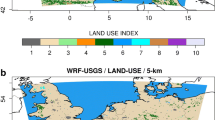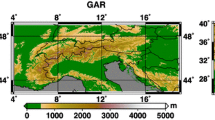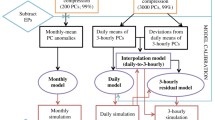Abstract
Changes in near surface air temperature (ΔT) in response to anthropogenic greenhouse gas forcing are expected to show spatial heterogeneity because energy and moisture fluxes are modulated by features of the landscape that are also heterogeneous at these spatial scales. Detecting statistically meaningful heterogeneity requires a combination of high spatial resolution and a large number of simulations. To investigate spatial variability of projected ΔT, we generated regional, high-resolution (25-km horizontal), large ensemble (100 members per year), climate simulations of western United States (US) for the periods 1985–2014 and 2030–2059, the latter with atmospheric constituent concentrations from the Representative Concentration Pathway 4.5. Using the large ensemble, 95 % confidence interval sizes for grid-cell-scale temperature responses were on the order of 0.1 °C, compared to 1 °C from a single ensemble member only. In both winter and spring, the snow-albedo feedback statistically explains roughly half of the spatial variability in ΔT. Simulated decreases in albedo exceed 0.1 in places, with rates of change in T per 0.1 decrease in albedo ranging from 0.3 to 1.4 °C. In summer, ΔT pattern in the northwest US is correlated with the pattern of decreasing precipitation. In all seasons, changing lapse rates in the low-to-middle troposphere may account for up to 0.2 °C differences in warming across the western US. Near the coast, a major control of spatial variation is the differential warming between sea and land.














Similar content being viewed by others
References
Barlage M et al (2010) Noah land surface model modifications to improve snowpack prediction in the Colorado Rocky Mountains. J Geophys Res 115:D22101. doi:10.1029/2009JD013470
Boulanger JP et al (2010) A Europe-South America network for climate change assessment and impact studies. Clim Change 98:307–329. doi:10.1007/s10584-009-9734-8
Bradley RS, Keimig FT, Diaz HF (2004) Projected temperature changes along the American cordillera and the planned GCOS network. Geophys Res Lett 31:L16210. doi:10.1029/2004GL020229
Christensen JH, Christensen OB (2007) A summary of the PRUDENCE model projections of changes in European climate by the end of the century. Clim Change 81:7–30. doi:10.1007/s10584-006-9210-7
Cox PM, Betts RA, Bunton CB, Essery RLH, Rowntree PR, Smith J (1999) The impact of new land surface physics on the GCM simulation of climate and climate sensitivity. Clim Dyn 15:183–203
Daly C, Halbleib MD, Smith JI, Gibson WP, Doggett MK, Taylor GH, Curtis J, Pasteris PA (2008) Physiographically-sensitive mapping of temperature and precipitation across the conterminous United States. Int J Climatol 28:2031–2064. doi:10.1002/joc.1688
Daly C, Conklin DR, Unsworth MH (2010) Local atmospheric decoupling in complex topography alters climate change impacts. Int J Climatol 30:1857–1864. doi:10.1002/joc.2007
Deser C, Philips AS, Bourdette V, Teng H (2012) Uncertainty in climate change projections: the role of internal variability. Clim Dyn 38:527–546. doi:10.1007/s00382-010-0977-x
Deser C, Phillips AS, Alexander MA, Smoliak BV (2014) Projecting North American climate over the next 50 years: uncertainty due to internal variability. J Clim 27:2271–2296. doi:10.1175/JCLI-D-13-00451.1
Diffenbaugh NS, Pal JS, Trapp RJ, Giorgi F (2005) Fine-scale processes regulate the response of extreme events to global climate change. Proc Natl Acad Sci 102:15774–15778. doi:10.1073/pnas.0506042102
Diffenbaugh NS, Ashfaq M, Scherer M (2011) Transient regional climate change: analysis of the summer climate response in a high-resolution, century-scale ensemble experiment over the continental United States. J Geophys Res Atmos 116:1–16. doi:10.1029/2011JD016458
Donlon CJ, Martin M, Stark J, Roberts-Jones J, Fiedler E, Wimmer W (2012) The operational sea surface temperature and sea ice analysis (OSTIA) system. Remote Sens Environ 116:140–158. doi:10.1016/j.rse.2010.10.017
Duffy PB, Arritt RW, Coquard J, Gutowski W, Han J, Iorio J, Kim J, Leung LR, Roads J, Zeledon E (2006) Simulations of present and future climates in the western United States with four nested regional climate models. J Clim 19:873–895. doi:10.1175/JCLI3669.1
Dulière V, Zhang Y, Salathé EP Jr (2011) Extreme precipitation and temperature over the U.S. Pacific Northwest: a comparison between observations, reanalysis data, and regional models. J Clim 24:1950–1964
Dulière V, Zhang Y, Salathé EP Jr (2013) Changes in twentieth-century extreme temperature and precipitation over the western United States based on observations and regional climate model simulations. J Clim 26:8556–8575. doi:10.1175/JCLI-D-12-00818.1
Giorgi F, Brodeur CS, Bates GT (1994) Regional climate change scenarios over the United States produced with a nested regional climate model. J Clim 7:375–399
Giorgi F, Hurrell JW, Marinucci MR, Beniston M (1997) Elevation dependency of the surface climate change signal: a model study. J Clim 10:288–296
Hawkins E, Sutton R (2009) The potential to narrow uncertainty in regional climate predictions. Bull Am Meteorol Soc 90:1095–1107. doi:10.1175/2009BAMS2607.1
Hawkins E, Sutton R (2011) The potential to narrow uncertainty in projections of regional precipitation change. Clim Dyn 37:407–418. doi:10.1007/s00382-010-0810-6
Hostetler SW, Alder JR, Allan AM (2011) Dynamically downscaled climate simulations over North America: Methods, evaluation, and supporting documentation for users: U.S. Geological Survey Open-File Report 2011-1238
Joshi MM, Gregory JM, Webb MJ, Sexton DM, Johns TC (2008) Mechanisms for the land/sea warming contrast exhibited by simulations of climate change. Clim Dyn 5:455–465
Kotlarski S, Bosshard T, Lüthi D, Pall P, Schär C (2012) Elevation gradients of European climate change in the regional climate model COSMO-CLM. Clim Change 112:189–215. doi:10.1007/s10584-011-0195-5
Letcher TW, Minder JR (2015) Characterization of the simulated regional snow albedo feedback using a regional climate model over complex terrain. J Clim 28:7576–7595. doi:10.1175/JCLI-D-15-0166.1
Leung LR, Ghan SJ (1999) Pacific Northwest climate sensitivity simulated by a regional climate model driven by a GCM. Part II: 2 × CO2 simulations. J Clim 12:2031–2053
Leung LR, Qian Y (2003) The sensitivity of precipitation and snowpack simulations to model resolution via nesting in regions of complex terrain. J Hydrometeor 4:1025–1043
Leung LR, Qian Y, Bian X, Washington WM, Han J, Roads JO (2004) Mid-century ensemble regional climate change scenarios for the western United States. Clim Change 62:75–113. doi:10.1023/B:CLIM.0000013692.50640.55
Li S, Mote PW, Rupp DE, Vickers D, Mera R, Allen MR (2015) Evaluation of a regional climate modeling effort for the western United States using a superensemble from weather@home. J Clim 28:7470–7488. doi:10.1175/JCLI-D-14-00808.1
Liang X-Z, Pan J, Zhu J, Kunkel KE, Wang JXL, Dai A (2006) Regional climate model downscaling of the U.S. summer climate and future change. J Geophys Res 111:D10108. doi:10.1029/2005JD006685
Livneh B, Xia Y, Mitchell KE, Ek MB, Lettenmaier DP (2010) Noah LSM snow model diagnostics and enhancements. J Hydrometeor 11:721–738. doi:10.1175/2009JHM1174.1
Lorenz EN (1963) Deterministic nonperiodic flow. J Atmos Sci 20:130–141
Lorenz DJ, DeWeaver ET (2007) Tropopause height and zonal wind response to global warming in the IPCC scenario integrations. J Geophys Res 112:D10119. doi:10.1029/2006JD008087
Mahoney K, Alexander M, Scott JD, Barsugli J (2013) High-resolution downscaled simulations of warm-season extreme precipitation events in the Colorado Front Range under past and future climates. J Clim 26:8671–8689. doi:10.1175/JCLI-D-12-00744.1
Maloney ED et al (2014) North American climate in cmip5 experiments: part iii: assessment of twenty-first-century projections. J Clim 27:2230–2270. doi:10.1175/JCLI-D-13-00273.1
Massey N, Jones R, Otto FEL, Aina T, Wilson S, Murphy JM, Hassel D, Yamazaki YH, Allen MR (2014) Weather@home—development and validation of a very large ensemble modelling system for probabilistic event attribution. Q J R Meteorol Soc. doi:10.1002/qj.2455
Mearns LO et al (2013) Climate change projections of the North American regional climate change assessment program (NARCCAP). Clim Change 120:965–975. doi:10.1007/s10584-013-0831-3
Meehl GA, Washington WM, Arblaster JM, Hu A, Teng H, Kay JE, Gettelman A, Lawrence DM, Sanderson BM, Strand WG (2013) Climate change projections in CESM1(CAM5) compared to CCSM4. J Clim 26:6287–6308. doi:10.1175/JCLI-D-12-00572.1
Meinshausen M et al (2011) The RCP greenhouse gas concentrations and their extensions from 1765 to 2300. Clim Change 109:213–241. doi:10.1007/s10584-011-0156-z
Mesinger MJ et al (2006) North American Regional Reanalysis. Bull Am Meteorol Soc 90:993–1007. doi:10.1175/BAMS-87-3-343
Mote PW, Allen MR, Jones RG, Li S, Mera R, Rupp DE, Salahuddin A, Vickers D (2015) Superensemble regional climate modeling for the western US. Bull Am Meteorol Soc. doi:10.1175/BAMS-D-14-00090.1
O’Brien TA, Sloan LC, Snyder MA (2011) Can ensembles of regional climate model simulations improve results from sensitivity studies? Clim Dyn 37:1111–1118. doi:10.1007/s00382-010-0900-5
Parajka J, Dadson S, Lafon T, Essery R (2010) Evaluation of snow cover and depth simulated by a land surface model using detailed regional snow observations from Austria. J Geophys Res Atmos 115:D24117. doi:10.1029/2010JD014086
Pavelsky TM, Kapnick S, Hall A (2011) Accumulation and melt dynamics of snowpack from a multiresolution regional climate model in the central Sierra Nevada, California. J Geophys Res Atmos 116:D16115. doi:10.1029/2010JD015479
Pavelsky TM, Sobolowski S, Kapnick S, Barnes JB (2012) Changes in orographic precipitation patterns caused by a shift from snow to rain. Geophys Res Lett 39:L18706. doi:10.1029/2012GL052741
Pepin N et al (2015) Elevation-dependent warming in mountain regions of the world. Nat Clim Change 5:424–430. doi:10.1038/nclimate2563
Plummer DA, Caya D, Frigon A, Côté H, Giguère M, Paquin D, Biner S, Harvey R, de Elia R (2006) Climate and climate change over North America as simulated by the Canadian RCM. J Clim 19:3112–3132. doi:10.1175/JCLI3769.1
Ramanathan V, Lian MS, Cess RD (1979) Increased atmospheric CO2: zonal and seasonal estimates of the effect on the radiation energy balance and surface temperature. J Geophys Res 84(C8):4949–4958. doi:10.1029/JC084iC08p04949
Rasmussen R et al (2011) High-resolution coupled climate runoff simulations of seasonal snowfall over Colorado: a process study of current and warmer climate. J Clim 24:3015–3048. doi:10.1175/2010JCLI3985.1
Rupp DE, Abatzoglou JT, Hegewisch KC, Mote PW (2013) Evaluation of CMIP5 20th century climate simulations for the Pacific Northwest USA. J Geophys Res Atmos 118:10884–10906. doi:10.1002/jgrd.50843
Salathé EP Jr, Steed R, Mass CF, Zahn P (2008) A high-resolution climate model for the United States Pacific Northwest: mesoscale feedbacks and local responses to climate change. J Clim 21:5708–5726
Salathé EP Jr, Leung LR, Qian Y, Zhang Y (2010) Regional climate model projections for the State of Washington. Clim Change 102:51–75. doi:10.1007/s10584-010-9849-y
Seager R, Goddard L, Nakamura J, Henderson N, Lee DE (2014a) Dynamical causes of the 2010/11 Texas-Northern Mexican drought. J Hydrometeor 15:39–68. doi:10.1175/JHM-D-13-024.1
Seager R, Neelin D, Simpson I, Liu H, Henderson N, Shaw T, Kushnir Y, Ting M, Cook B (2014b) Dynamical and thermodynamical causes of large-scale changes in the hydrological cycle over North America in response to global warming. J Clim 27:7921–7948. doi:10.1175/JCLI-D-14-00153.1
Šeparović L, Alexandru A, Laprise R, Martynov A, Sushama L, Winger K, Tete K, Valin M (2013) Present climate and climate change over North America as simulated by the fifth-generation Canadian regional climate model. Clim Dyn 41:3167–3201. doi:10.1007/s00382-013-1737-5
Sheffield J et al (2013) North American climate in CMIP5 experiments. Part 1: evaluation of historical simulations of continental and regional climatology. J Clim 26:9209–9245. doi:10.1175/JCLI-D-12-00592.1
Sutton RT, Dong B, Gregory JM (2007) Land/sea warming ratio in response to climate change: IPCC AR4 model results and comparison with observations. Geophys Res Lett 34:L02701. doi:10.1029/2006GL028164
Taylor KE, Stouffer RJ, Meehl GA (2012) An overview of CMIP5 and the experiment design. Bull Am Meteorol Soc 93:485–498. doi:10.1175/BAMS-D11-97300094.1
van der Linden P, Mitchell JFB (2009) ENSEMBLES: Climate change and its impacts: Summary of research and results from the ENSEMBLES project, technical report, Met Off. Hadley Cent, Exeter
Wang J, Kotamarthi VR (2015) High-resolution dynamically downscaled projections of precipitation in the mid and late 21st century over North America. Earth’s Future 3:268–288. doi:10.1002/2015EF000304
Wang Z, Zeng X, Decker M (2010) Improving snow processes in the Noah land model. J Geophys Res Solid Earth 115:D20108. doi:10.1029/2009JD013761
Wang C, Jones R, Perry M, Johnson C, Clark P (2013) Using an ultrahigh-resolution regional climate model to predict local climatology. Q J R Meteorol Soc 139:1964–1976. doi:10.1002/qj.2081
Zhang Y, Dulière V, Mote P, Salathé EP Jr (2009) Evaluation of WRF and HadRM mesoscale climate simulations over the United States Pacific Northwest. J Clim 22:5511–5526
Acknowledgments
The work was supported in part by the U.S. Department of Agriculture, National Institute of Food and Agriculture (USDA-NIFA), via the Regional Approaches to Climate Change—Pacific Northwest Agriculture (REACCH PNA, USDA-NIFA Grant 2011068002-30191) project and USDA-NIFA Grant 2013-67003-20652, and Sihan Li was funded through a Department of the Interior Northwest Climate Science Center graduate fellowship. The authors thank Andy Bowery, Friederike Otto, and the entire team at Weather@home for their assistance and the thousands of volunteers who supplied computing power for this study, and also thank Richard Betts from the UK Met Office Hadley Centre and William Ingram from the University of Oxford for their expert consultation. Weather@home uses The Berkeley Open Infrastructure for Network Computing (BOINC), which is supported by the National Science Foundation through awards SCI-0221529, SCI-0438443, SCI-0506411, PHY/0555655, and OCI-0721124. The data used for this paper are available by request from the corresponding author.
Author information
Authors and Affiliations
Corresponding author
Electronic supplementary material
Below is the link to the electronic supplementary material.
Appendices
Appendix 1: Generation of future SSTs
SSTs for the future period were created by adding a change (Δ) in SST to the observed SST in the OSTIA data. The OSTIA data are provided at a 1/20°-resolution so are first regridded to the N96 grid used in HadAM3P.
The ΔSSTs are varied month-by-month and cell-by-cell. The ΔSSTs were derived by differencing SSTs in the future and historic periods as simulated using a coupled atmospheric-ocean GCM. The multiple-step process was as follows:
-
1.
SSTs from the CMIP5 historical experiment (1850–2005) were concatenated with those from the CMIP5 RCP 4.5 experiment (2006–2100).
-
2.
Three-dimensional arrays X i (latitude, longitude, time) of monthly SST were generated for the period 1900–2099 for each calendar month i: a total of 12 arrays.
-
3.
X i for each i was temporally smoothed using a Gaussian filter along a moving window of 31 years. The standard deviation of weights was scaled to the size the window and was ~5.6 years.
-
4.
ΔSSTs were calculated by subtracting the smoothed SSTs for the period December 1985 to November 2014 from the smoothed SSTs for the period December 2030 to November 2059 (e.g. December 2030 minus December 1985).
-
5.
ΔSSTs were regridded to the N96 grid used in HadAM3P.
-
6.
ΔSSTs were interpolated over land to avoid coastline mismatch between HadAM3P and the CMIP5 GCM, and the HadAM3P land mask was applied.
-
7.
ΔSSTs were spatially smoothed using a Gaussian filter.
-
8.
ΔSSTs were added to the regridded OSTIA SSTs for the period December 1985 to November 2014 to derive SSTs for the period December 2030 to November 2059.
Appendix 2: Model spin-up
The strength of Weather@home is its ability to generate very large ensemble of short runs (e.g. 1-year long) relatively quickly. A compromise for this strength is that runs of many consecutive years (as typically done during spin-up) are cumbersome. The spin-up procedure described below arose out of a need to balance available resources with efficacy while operating within the Weather@home structure; in other words, to avoid continuous, multi-decadal spin-up runs.
For the historical scenario, the spin-up began with an existing single 10-year long continuous simulation ending in 1967.11 (see Massey et al. 2014). The final model state from this run, saved in a “restart” file, was then used to provide the initial conditions for each of 28 single-year runs beginning in December of the years 1985 through 2012 and ending November 1986 through 2013. Next, the restart files from each of these 28 simulations were used as the initial conditions of single-year simulations beginning in December of the years 1986–2013. The restart file from 1986.11 was used to initialize 1985.12 because there was no simulation ending in 1985.11.
For the future, a historical run, spun-up using the above method, seeded the spin-up procedure: a restart file from 2011.11 was used to initialize single-year simulations beginning 2030.12, 2035.12, 2040.12, 2045.12, 2050.12, and 2055.12. Next, the restart files for each of these 6 runs initialized at least four single-year runs in consecutive years. For example, the restart file from 2031.11 initialized 2030.12, 2031.12, 2032.12, 2033.12, 2034.12, and 2035.12, while the 2036.11 restart file initialized 2036.12, 2037.12, 2038.12, 2039.12, and 2040.12. Lastly, the restart files from each of these 28 simulations ending in 2030.11 through 2057.11 were used as the initial conditions of single-year simulations beginning in December of the years 2031–2057. The new restart file from 2031.11 was also used to initialize 2030.12 because there was no simulation ending in 2030.11. In summary, each modeled year in the future scenario underwent 15 years of spin-up, of which the last 3 spin-up years were driven by the forcings and boundary conditions of the year’s respective time period under RCP 4.5.
Rights and permissions
About this article
Cite this article
Rupp, D.E., Li, S., Mote, P.W. et al. Seasonal spatial patterns of projected anthropogenic warming in complex terrain: a modeling study of the western US. Clim Dyn 48, 2191–2213 (2017). https://doi.org/10.1007/s00382-016-3200-x
Received:
Accepted:
Published:
Issue Date:
DOI: https://doi.org/10.1007/s00382-016-3200-x




